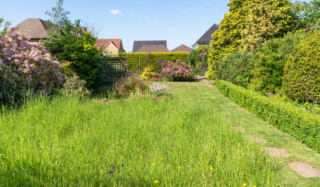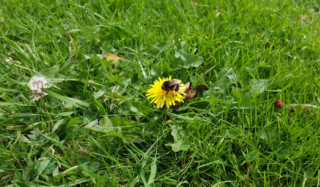No Mow May and Grow It, Don’t Mow It
Giving the lawn its first manicured haircut of the season is a spring ritual. But what if you didn’t? The Canadian Wildlife Federation (CWF) doesn’t think it’s that far-fetched. The Grow it! Don’t Mow it! campaign encourages letting your lawn grow to protect and provide habitats for insects, bees, butterflies, and other pollinators.

In Britain, Plantlife, a non-profit environmental group whose mission is to secure a world rich in wild plants and fungi, also promotes a No Mow May campaign. Just one month of not mowing your lawn will lower your carbon footprint and conserve water.
Carbon Sequester
Like all plants, grass absorbs carbon dioxide during photosynthesis. The carbon converts into sugars that feed that plant and the microscopic life in the soil. The sequestered carbon is released back into the atmosphere when the grass is cut. But, of course, if you don’t mow your lawn, this won’t happen.
Air Pollution
The United States has 40 million acres of lawn, including homes, cemeteries, athletic fields, boulevards, and parks. Gas-powered mowers and edgers maintain this vast amount of grass, releasing carbon into the atmosphere.
Water Conservation
Every time the lawn is cut, the grass has to re-initialize its growth cycle. By letting your lawn grow, the grass establishes a more natural growth pattern. Without constant disruption, roots can establish themselves and dig deep, aerating the underlying layers of the earth. This allows the ground to absorb more moisture. As the grass grows and thickens, it shades the soil, allowing it to hold the water so the ground stays hydrated for longer.
Insects and Pollinators

According to the CWF, between 40 and 70% of insect species are in decline worldwide. Not mowing the lawn and letting dandelions and other wildflowers take over allows for habitat and an ongoing food source. Clipped, non-native grasses do not provide the food and shelter essential pollinators need to survive. Most of the world’s food supply relies on pollinators – without them, we don’t survive.
Pest Prevention
Beneficial insects such as ladybugs, lacewings, and ground beetles help pollinate the garden and keep aphids, spider mites, scales, and mealybugs at bay. By keeping the grass long and letting wildflowers and weeds grow, you provide them with a home, and in return, they offer the rest of the garden protection.
Helping Birds
Letting your lawn grow will make the birds in your neighborhood very happy, especially during spring. The dried-up, dead stems and stalks of tall grass make excellent nesting materials.
It’s hard to say goodbye to the lawn mower, but maybe one final benefit of not mowing the lawn for a month or longer is the possibility of new garden space. Just imagine vegetables growing where grass used to be or, in the summer, the vibrancy of sunflowers and echinacea attracting butterflies and hummingbirds. All that, plus a lower carbon footprint. Anytime that happens in the era of climate change is a good day for planet Earth and all of us!




